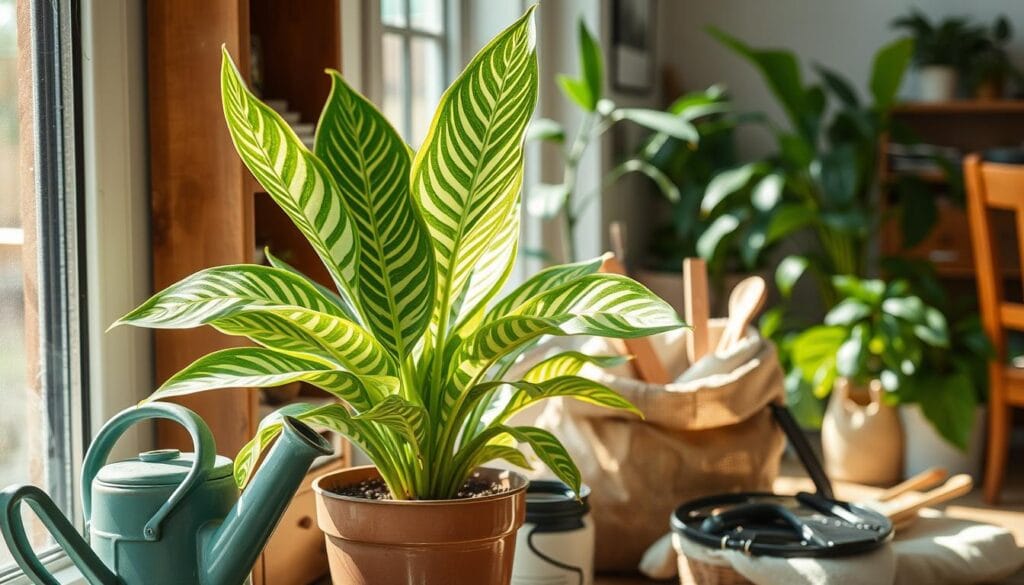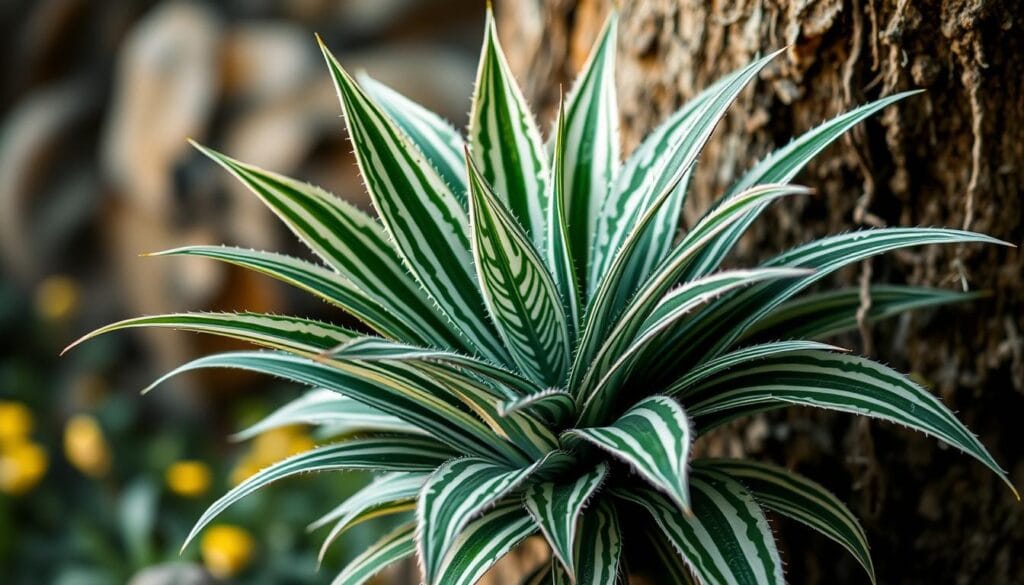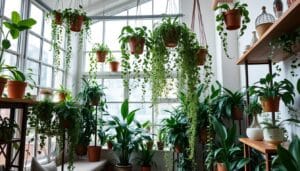zebra plant, also known as Haworthia fasciata, is a stunning succulent. It’s loved by many for indoor gardening. Its unique striped leaves and easy care make it perfect for homes or offices. This guide will help you grow a healthy zebra plant.
Key Takeaways
- The zebra plant is a succulent native to South Africa with distinctive striped leaves.
- Zebra plants thrive in bright, indirect sunlight and require well-draining soil to prevent root rot.
- Proper watering, temperature, and humidity management are crucial for the plant’s health and longevity.
- Zebra plants are relatively low-maintenance and can be propagated through leaf cuttings or division.
- Regular grooming and seasonal care adjustments will ensure your zebra plant remains vibrant and beautiful.
Understanding the Zebra Plant: Origins and Characteristics
The zebra plant, also known as the zebra haworthia, comes from South Africa’s dry lands. It’s loved for its striped foliage and easy care. It’s a popular air purifying plant in homes and offices.
Native Habitat and Natural Growing Conditions
The zebra plant grows in South Africa’s Karoo region. It loves rocky, well-draining soil and lots of sun. Its home is hot and dry, which made it strong and special.
Distinctive Features and Plant Varieties
The zebra plant’s leaves look like a zebra’s stripes. There are many varieties, each with different leaf shapes, sizes, and colors. You can find them in green, white, and even purple.
Benefits of Growing Zebra Plants Indoors
Zebra plants are great for indoor spaces. They’re tough and good at cleaning the air. They make any room look better with their natural beauty.
“The zebra plant is a low-maintenance, yet visually captivating addition to any indoor garden.”
Essential Growing Requirements for Your Zebra Plant
Zebra plants are a favorite among indoor gardeners because they are easy to care for and can handle dry conditions. To keep your zebra plant happy and healthy, it’s important to know what it needs. This includes the right amount of light, water, soil, and temperature.
Lighting Needs
Zebra plants love bright, indirect sunlight. Direct sunlight can burn their leaves. The best spot for your zebra plant is near an east- or west-facing window.
Watering and Soil Requirements
It’s key to keep the soil of your zebra plant moist but not too wet. Water it when the top inch of soil feels dry. Use a soil mix that drains well and is rich in nutrients to prevent root rot.
- Choose a potting mix made for low maintenance and drought tolerant plants.
- Make sure the soil isn’t too wet, as this can cause root rot.
Temperature and Humidity Preferences
Zebra plants do best in warm temperatures, above 60°F (15°C). They also like humid environments. You can increase the air moisture by misting the leaves or using a pebble tray.

“Proper care and attention to the zebra plant’s growing requirements are essential for its long-term health and vibrant appearance.”
By meeting your zebra plant’s needs, you can enjoy a beautiful, low maintenance, drought tolerant houseplant. It will add a unique and striking element to your home.
Optimal Light Conditions and Placement
For a zebra plant to grow well, it needs the right light. These succulents have special light needs that are important for indoor plants.
Direct vs Indirect Sunlight Requirements
Zebra plants love bright, indirect sunlight. They can handle some direct sun, but too much can burn their leaves. The best spot is near a sunny window with filtered light all day.
Best Indoor Locations for Thriving Growth
- East-facing or west-facing windows are great for bright, indirect light.
- Avoid direct southern sun, as it’s too strong for your zebra plant.
- If your home is dark, use a grow light to help your plant.
Seasonal Light Adjustments
As seasons change, you might need to move your zebra plant. In summer, when days are long, move it back a bit to avoid burning. In winter, when sun is weak, bring it closer to the window for more light.
| Season | Light Conditions | Placement Recommendation |
|---|---|---|
| Summer | Bright, direct sunlight | Move plant slightly farther from window |
| Winter | Less intense sunlight | Position plant closer to window |

Understanding your zebra haworthia‘s light needs helps it thrive all year. Make changes as needed to keep it looking great.
Watering Schedule and Moisture Management
Properly caring for your zebra plant means finding the right watering balance. This drought-tolerant succulent loves well-drained soil and moderate moisture. But, it’s easy to overwater or underwater, which can harm it.
To keep your zebra plant healthy, water it once a week in spring and summer. Let the soil dry a bit before watering again. In fall and winter, when it grows slower, water it every two to three weeks.
- Always check the soil moisture before watering – stick your finger into the soil up to the second knuckle. If the soil is still damp, hold off on adding more water.
- Water thoroughly, allowing the excess to drain out the bottom of the pot. Avoid letting the plant sit in standing water.
- Adjust watering frequency based on your zebra plant’s location, the time of year, and your indoor climate. Plants in brighter, warmer spots will need more water.
By following these simple guidelines, you can ensure your zebra plant receives the right amount of moisture to thrive as the drought-tolerant beauty it is.

Soil Requirements and Potting Techniques
Choosing the right soil and potting techniques is key for your haworthia, or zebra plant. This popular indoor plant needs the right soil and repotting to thrive at home.
Best Soil Mixtures for Proper Drainage
Zebra plants need a soil mix that drains well. Mix potting soil with perlite and coarse sand or small gravel. This mix keeps roots healthy and prevents waterlogging, which can cause root rot.
Repotting Guidelines and Timing
Repot your zebra plant every 2-3 years or when the roots are crowded. Spring is the best time to do this. Be gentle with the roots and choose a pot only slightly larger than the old one.
Container Selection Tips
| Container Material | Key Considerations |
|---|---|
| Terracotta | Allows for excellent air circulation and drainage |
| Ceramic | Elegant and decorative, but may retain moisture more than terracotta |
| Plastic | Inexpensive and lightweight, but can trap excess moisture if not well-draining |
Choose a container with lots of drainage holes to avoid waterlogging. The pot should be a bit bigger than the root ball to support growth.
“Providing the right soil and potting conditions is key to keeping your zebra plant healthy and happy in your home.”
Temperature and Humidity Needs
Keeping the right temperature and humidity is key for your zebra plant to grow well. These factors help your zebra plant stay healthy and green.
Zebra plants like temperatures between 65°F and 75°F (18°C and 24°C). They can handle a bit cooler or warmer, but avoid extreme temperatures. In summer, keep them away from direct sunlight to prevent leaf scorch.
Zebra plants also need a humid environment, best between 40% to 60% humidity. To keep humidity right, mist the leaves, use a pebble tray, or get a humidifier. This is especially important in dry winter months.
| Environmental Factor | Ideal Range | Potential Issues |
|---|---|---|
| Temperature | 65°F to 75°F (18°C to 24°C) | Extreme temperatures can lead to leaf damage or plant stress |
| Humidity | 40% to 60% | Low humidity can cause the leaves to become dry and crisp |
By watching and adjusting temperature and humidity, you create the best home for your zebra plant. With proper care, your indoor succulent will bring natural beauty to your home.

“Providing the right temperature and humidity conditions is essential for the long-term health and vibrant growth of your zebra plant.”
Fertilization and Nutrient Requirements
Proper fertilization is crucial for your zebra haworthia to stay healthy and grow well. This houseplant is known for being easy to care for. Knowing what it needs helps you feed it right, avoiding too much fertilizer.
Types of Fertilizers to Use
Choose a balanced, water-soluble fertilizer made for succulents and cacti. These formulas have more phosphorus and potassium than nitrogen. This supports strong roots and plant health. Don’t use regular houseplant fertilizer, as it has too much nitrogen and can harm your plant.
Seasonal Feeding Schedule
- Spring and Summer: Feed your zebra haworthia every 4-6 weeks with a diluted succulent fertilizer solution, following the manufacturer’s instructions.
- Fall and Winter: Reduce feeding to once every 2-3 months, as the plant’s growth slows during the cooler, shorter days.
- Avoid fertilizing during the plant’s dormancy period in the winter, as this can lead to root damage or other issues.
Following a balanced, seasonal feeding schedule helps your zebra haworthia get the nutrients it needs. This way, it thrives as a low-maintenance houseplant.

Common Problems and Troubleshooting
Zebra plants are tough, but they can still face issues. Spotting and fixing these problems early keeps your succulent looking great.
Discoloration or yellow leaves often mean too much water, not enough light, or missing nutrients. Change how you water, give it more light, or use a balanced fertilizer to fix it.
Pests like mealybugs or spider mites can harm your zebra plant. These bugs eat the leaves and stems. Check your plant often and treat any pests with a safe insecticide to keep them away.
“Maintaining the health and vitality of your zebra plant is a rewarding journey that requires a keen eye and a bit of troubleshooting.”
Leaves that brown or curl might be stressed from temperature changes or low humidity. Make sure your zebra plant is in a stable, comfy spot to solve these problems.
By watching for and fixing issues quickly, your zebra plant will stay healthy and lovely. With proper care, it will bring joy for many years.
Propagation Methods and Techniques
Expanding your collection of haworthia, or zebra plants, is exciting and rewarding. These succulents can be grown in many ways. This lets you share your love for these plants with others. Let’s look at how to do leaf cuttings and division, two common ways to grow zebra plants.
Leaf Cutting Propagation Steps
Leaf cuttings are an easy way to grow a zebra plant. Just cut a healthy leaf from the base of the plant. Make sure the cut is clean and even. Let the leaf dry for a few days to form a callus.
Then, put the leaf in a succulent potting mix that drains well. Water it a little and give it bright, indirect light. Soon, you’ll see roots and a new plant growing from the leaf.
Division and Offset Separation
Zebra plants often grow offsets at their base. These small plants can be separated and grown on their own. To do this, dig around the base of the plant to find the offsets.
Use a sharp knife or scissors to cut the offsets from the main plant. Put the offsets in their own pots. Water and care for them like you would a full-grown zebra plant.
Propagation needs patience and careful attention. With the right care, you can grow a beautiful collection of succulents. Happy propagating!
Seasonal Care and Maintenance Tips
Caring for your zebra haworthia means adjusting your routine with the seasons. Knowing when and how to care for it ensures it stays healthy and beautiful. This is key for your zebra plant.
In spring and summer, your zebra haworthia needs lots of sunlight and regular water. As days get longer, water it more often. Also, fertilize every 4-6 weeks to help it grow strong leaves and flowers.
When autumn comes, start watering less. This helps your plant get ready for its dormant period. Also, move it to a brighter spot to keep it well-lit during this time.
- In winter, water your zebra plant just enough to keep the soil moist.
- Don’t fertilize during the dormant season. Your zebra haworthia won’t need it.
- Keep an eye out for pests or diseases. Fix any problems quickly to keep your plant healthy.
Adjusting your care routine with the seasons helps your zebra haworthia thrive. It makes it a lovely, easy-to-care-for part of your houseplant collection.
Conclusion
The zebra plant is a fascinating succulent known for its unique look and easy care. It’s perfect for any indoor spot. You now know how to grow a healthy zebra plant at home.
For your zebra plant to thrive, give it the right light, water it correctly, and use the best soil and temperature. With some care, it will show off its beautiful leaves and add to your indoor garden.
Following the tips in this guide is key to success. By doing so, you’ll enjoy the beauty and simplicity of the zebra plant. Let it bring joy and beauty to your home.





